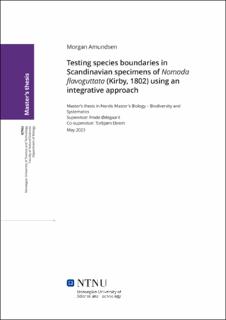Testing species boundaries in Scandinavian specimens of Nomada flavoguttata (Kirby, 1802) using an integrative approach
Master thesis
Permanent lenke
https://hdl.handle.net/11250/3086274Utgivelsesdato
2023Metadata
Vis full innførselSamlinger
- Institutt for biologi [2596]
Sammendrag
Kleptoparasittiske bier utgjør omtrent 13% av alle verdens biearter. Deres spesialiserte økologi gjør at de er gode indikatorer på tilstanden i terrestriske økosystemer. Nomada er den største slekten av kleptoparasitiske bier. Tidligere strekkodede Nomada flavoguttata individer fra Skandinavia blir delt inn i tre godt understøttede klader. I dette prosjektet testet jeg artsavgrensningen mellom disse tre kladene. Ved å bruke en integrert tilnærming så jeg på molekylær, morfologisk, og økologisk data. Fem gensegmenter (COI, 16S, 28S, ITS-2, og EF1-α) ble sekvensert og analysert ved bruk av flere metoder for artsavgrensning (GMYC, PTP, BPP, og ASAP). I tillegg testet jeg for Wolbachia, en endosymbiontisk mikroorganisme som i noen tilfeller manipulerer de genetiske linjene til leddyr. Resultatene fra de forskjellige metodene for molekylær artsavgrensning var motstridene, enten en eller tre arter ble foreslått. Ingen av de undersøkte morfologiske karakterene viste seg å være egnet til å sikkert skille kladene. Hvorvidt den genetiske variasjonen i Nomada flavoguttata er tilknyttet vertsart forblir uløst. Det ble oppdaget en veldig lav infeksjonsrate (2.6%) av Wolbachia hos N.flavoguttata. Bare ett individ var infisert og det ble plassert sammen med de uinfiserte individene, noe som tyder på at Wolbachia ikke har påvirket det genealogiske slektskapet indikert av mtDNA hos Nomada flavoguttata. Cleptoparasitic bees comprise approximately 13% of all the world’s bee species. Their specialized ecology makes them good indicators for assessing the status of terrestrial ecosystems. Nomada is the largest genus of cleptoparasitic bees. Previously barcoded Nomada flavoguttata specimens from Scandinavia are placed in three well-supported clades. In this project, I tested the species boundaries of these three clades using an integrative approach, looking at molecular, morphological, and ecological data. Five gene segments (COI, 16S, 28S, ITS-2, and EF1-α) were sequenced and analyzed using several methods for species delimitation (GMYC, PTP, BPP, and ASAP). In addition, I screened for Wolbachia, an endosymbiotic microorganism known to occasionally manipulate arthropod genealogical lineages. The results from the different methods for molecular species delimiting were conflicting, suggesting either one or three species. None of the morphological characters investigated proved to be good at confidently separating the clades. Whether or not the genetic diversity of N. flavoguttata is linked to host association remains unsolved. A very low infection frequency (2.6%) of Wolbachia was detected in N. flavoguttata. Only one specimen was infected, and it was placed alongside the uninfected specimens, suggesting that Wolbachia has not affected the genealogical relationships indicated by mtDNA in N. flavoguttata.
